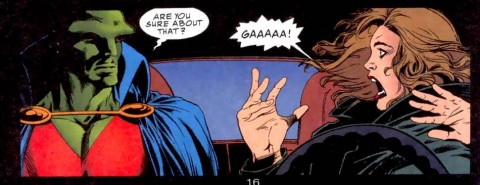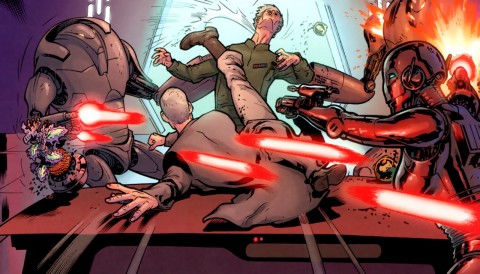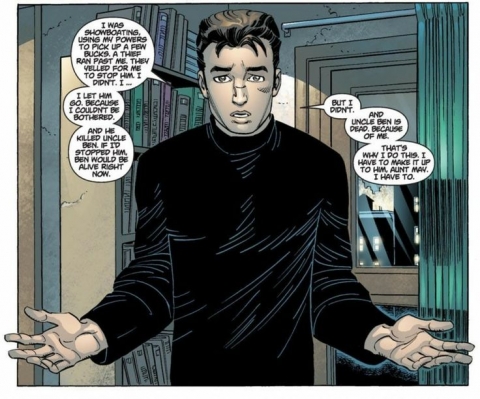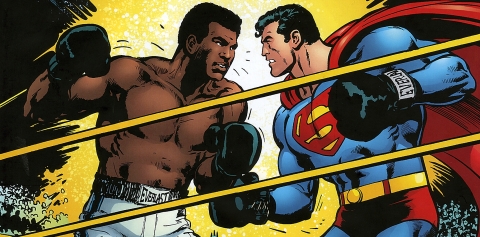52 weeks. 52 different writers. 2 trade paperbacks or hardcovers a week. Each week I’ll take a look at a different writer and read two different collected editions from within that person’s repertoire to help in the examination of their work.
John Ostrander may be most well known for creating the modern version of Task Force X, otherwise known as The Suicide Squad, back in 1987. Ostrander has had a plethora of notable work under the DC Comics banner, penning series for Firestorm, Hawkworld, Manhunter, and The Spectre. With his frequent collaborator Tom Mandrake, the two men brought a long running Martian Manhunter series to life back in the late 1990’s, at the height of JLA’s popularity during Grant Morrison’s run.
Martian Manhunter: Son Of Mars
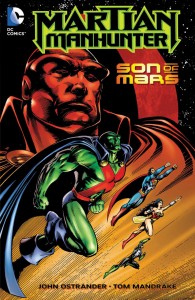 Martian Manhunter, a martian native to Mars otherwise known as J’onn J’onzz, is one of the most fascinating and longest running members of the Justice League. Possessing powers that are nearly on par with that of Superman’s, Martian Manhunter fights for justice alongside other members of the League. Taking on the alias of John Jones, a deceased Chicago detective, Manhunter examines humans through several different perspectives, taking on the identities of other dead humans. When a mysterious enemy begins to strike out against the personal lives of J’onzz’s aliases and his own, he must work quickly to discover who exactly is out to ruin his life before they turn everyone, including the Justice League, against him.
Martian Manhunter, a martian native to Mars otherwise known as J’onn J’onzz, is one of the most fascinating and longest running members of the Justice League. Possessing powers that are nearly on par with that of Superman’s, Martian Manhunter fights for justice alongside other members of the League. Taking on the alias of John Jones, a deceased Chicago detective, Manhunter examines humans through several different perspectives, taking on the identities of other dead humans. When a mysterious enemy begins to strike out against the personal lives of J’onzz’s aliases and his own, he must work quickly to discover who exactly is out to ruin his life before they turn everyone, including the Justice League, against him.
John Ostrander expands on many interesting and intricate elements of Martian Manhunter with his solo series from the late 1990’s. Under Ostrander’s hand, J’onn J’onzz became a far more complex character than he’d ever been before, with Ostrander adding many intriguing new elements to him both physically and emotionally. This first collection goes into depth about J’onzz’s personal life both on Earth and his former life on Mars. While you technically don’t get a definitive origin in this series, you do get a rather strong explanation as to why he ultimately ended up on Earth in the first place.
Ostrander spends the vast majority of the story set in the “present” day, with J’onn being a proud member of the Justice League of America as well as inhabiting several different aliases to examine human life under different views. There are a few moments where Ostrander delves into Manhunter’s tragic past, showing the reader why he was initially driven off of Mars, revealing that it is was his evil brother, Ma’alefa’ak, who ultimately eradicated all of his species from the planet due to his corrupt ways. Ostrander uses these different story lines to help guide one another other, using the past to inform the present and vice versa. The payoff comes late in the story with both tales converging for a climatic battle between brothers. It feels like an inevitable clash from the first moment J’onzz mentions his brother, lacking an element of surprise but still being satisfying nonetheless.
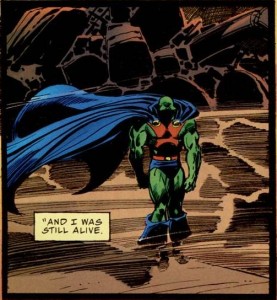 Ostrander does a great job of making every issue accessible through his style of storytelling. Each issue is a predominately contained tale, telling you everything you need to know and usually wrapping up in a matter that feels rewarding. Ostrander does lace together a few strands of plot across a couple of issues but for the most part each story is rather independent until you reach the last few issues, which heavily rely on events that have already occurred to set up a dramatic finale.
Ostrander does a great job of making every issue accessible through his style of storytelling. Each issue is a predominately contained tale, telling you everything you need to know and usually wrapping up in a matter that feels rewarding. Ostrander does lace together a few strands of plot across a couple of issues but for the most part each story is rather independent until you reach the last few issues, which heavily rely on events that have already occurred to set up a dramatic finale.
The most interesting part of this first collection of Manhunter stories has to be the multiple aliases he chooses to use for the duration of story. It adds another layer of emotion to the character of J’onn J’onzz as you see the different walks of life he experiences. From trying to be a Chicago detective, to a Chinese businessman or even a clumsy super villain, J’onzz never really rejects the opportunity to learn about how or what makes humans unique. Exploring these difference personalities, as well as their character relationships, through the body of J’onzz is a great bit of work by Ostrander and provides equal amounts of serious story beats with great comedy to back it up at times.
As much time as Ostrander spends humanizing J’onzz for the reader, he spends a fair amount of time playing up how different he is from humans as well, giving us a chance to see how he lived as a Martian. In making the primary antagonist to the story the evil brother of J’onzz you’re immediately given a personal tale. This is what truly provides Ostrander with a springboard to jump between the past and the present, honing in on the martian life of J’onzz on Mars. It becomes an incredibly tragic tale when you learn about how he lost his wife and daughter because of his brother, making you sympathize with the character in a whole new way. The past storyline establishes why J’onzz brother is such a threat while Ostrander uses the present timeline to further cement his bad guy status. It all provides fairly rich character moments for J’onzz as the showdown between the two brothers boils off satisfyingly.
The true weakness to the series tends to be the delivery of some of the story beats by Ostrander. Although Ostrander brings a plethora of fascinating ideas to the table, some of the moments where he shifts the narrative into the past tend to fall flat. There’s one scene in particular, where Martian explains the war between the different types of his species, that is so forgettable that you might need to read it twice because you retain none of the information presented. It just feels like an out of place story beat that could have been used more wisely towards developing J’onzz’s other character relations.
Collects: Martian Manhunter #0-9.
Best Character: Martian Manhunter.
Best Line Of Dialogue/Caption: “I can’t think of anything more central to my being. I am the League and the League is me.” – Martian Manhunter.
Best Scene/Moments: J’onnz becomes the super villain, Big Spud – Issue 4.
Best Issue: Issue 6. What makes issue 6 enjoyable is that it’s your classic disassembling story for a superhero. This is the issue where J’onnz is cast in a negative light against his fellow Justice Leaguers of Wonder Woman, Aquaman and Steel, as they discover a mysterious base on Mars that is seemingly J’onnz’s new home. Inside the base it appears as though J’onnz has been conducting sick experiments on creatures. The three League members go up against their ally in a story that, although predictable, still has a concise plot with a clear beginning, middle, and end.
Why You Should Read It: J’onn J’onzz is one the more well liked members of the original Justice League to never really get a strong solo series. Ostrander puts his best foot forward here in an attempt to give the character some semblance of humanity and intrigue. Working hard to integrate the character into human civilization whilst also isolating him as an oddity, Ostrander succeeds in giving the reader some depth to absorb from the Martian Manhunter. This series of stories gives the character plenty of new layers that will help you better understand who the character truly is.
Star Wars: Agent Of The Empire Vol 1 – Iron Eclipse
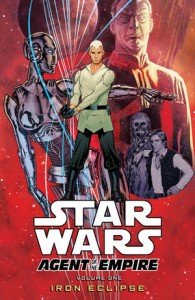 John Ostrander is no stranger to writing for the world of Star Wars comics. Having penned many well loved Star Wars series for Dark Horse, such as Star Wars: Legacy, Star Wars: Dawn Of The Jedi, and even greatly contributing to Star Wars: Republic, Ostrander has shown time after time that he is a great candidate for writing anything Star Wars related. With Star Wars: Agent Of The Empire, Ostrander tried to craft a spy thriller set within the Star Wars universe, throwing in James Bond elements with the classic Sci-Fi realm.
John Ostrander is no stranger to writing for the world of Star Wars comics. Having penned many well loved Star Wars series for Dark Horse, such as Star Wars: Legacy, Star Wars: Dawn Of The Jedi, and even greatly contributing to Star Wars: Republic, Ostrander has shown time after time that he is a great candidate for writing anything Star Wars related. With Star Wars: Agent Of The Empire, Ostrander tried to craft a spy thriller set within the Star Wars universe, throwing in James Bond elements with the classic Sci-Fi realm.
Jahan Cross is an agent of the Empire, doing mission off the radar for the betterment of the Empire’s stranglehold on the Galaxy. With his bot IN-GA 44, Jahan goes undercover to discover a strange plot involving the royal Stark family. With high-flying action and excitement that whisks him to every end of the galaxy, Jahan Cross has just as many friends as he does enemies. With allies like Han Solo and Chewbacca in his corner, as well as men like Iaclyn Stark opposing him, Jahan Cross is always up for just as much trouble as he is excitement.
Agent of The Empire is most readily compatible to Star Wars meeting with James Bond to tell a fun tale. Jahan Cross is more Han Solo than the man himself, being a charismatic ladies man who tends to get into more trouble than he’s worth. Tasked by the Empire to investigate the Stark family, Jahan Cross stumbles across the Iron Eclipse, a mysterious “casino” run by Iaclyn Stark. As Jahan investigates, he meets the beautiful sister to Iaclyn, Elli, and also quickly strikes up a romance with her stepmother, Dah’lis Stark. When Dah’lis is murdered, Jahan Cross is quickly held responsible in an obvious frame job by Iaclyn. Jahan must work quickly to not only clear his name but also discover what the true purpose of the Iron Eclipse is.
As I said above, Jahan Cross is basically James Bond tailor-made for a Star Wars story. He’s an exciting and charming spy who makes Han Solo look like a choir boy. Ostrander embodies all the elements you’d need to make a main character like this compelling, giving him a great past tied to the Star Wars lore and making him equally vulnerable as he is cunning. At his best, Jahan keeps you hooked in with his snappy dialogue and exciting adventures. At his worst he drones on with political chit-chat with his superior. These are both the high and low points of the series as Ostrander unfurls plenty of great character moments for Jahan while also trying to strike the balance of telling a solid tale.
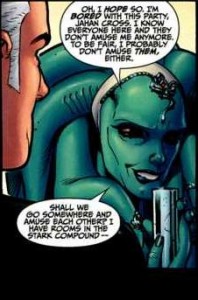 The big problem with Agent of the Empire is also one of the best parts about it too; it’s set in the world of Star Wars. There is plenty of rich lore for Ostrander to draw upon but for people who aren’t keen on following the way that Star Wars chooses to tell its stories, you may feel lost or overwhelmed at parts. The story takes plenty of liberal jumps, having moments where you feel Ostrander is telling far more than he is showing. The character names for your antagonists all feel remarkably similar, creating confusion at times as to which character is which. When all you have is a story that feels like it’s being told to you, it’s easy to zone out and miss the point of particular scenes, like the lightning fast exposition that explains who Iaco Stark is and why he relates to the Hyperspace War.
The big problem with Agent of the Empire is also one of the best parts about it too; it’s set in the world of Star Wars. There is plenty of rich lore for Ostrander to draw upon but for people who aren’t keen on following the way that Star Wars chooses to tell its stories, you may feel lost or overwhelmed at parts. The story takes plenty of liberal jumps, having moments where you feel Ostrander is telling far more than he is showing. The character names for your antagonists all feel remarkably similar, creating confusion at times as to which character is which. When all you have is a story that feels like it’s being told to you, it’s easy to zone out and miss the point of particular scenes, like the lightning fast exposition that explains who Iaco Stark is and why he relates to the Hyperspace War.
As much as one could complain about how the story feels more tell than show with some so-so exposition, there are moments where Ostrander just nails the use of said literary tool. The perfect example of exposition done right is the brief character history you get late in the game explaining Jahan’s past. You learn about how he was on planet during the battle of Coruscant and how that effected his character in the long run. It’s a rather brief explanation but one that works nonetheless due to the emotion Ostrander instills into the quick scene. It explains a few things that Jahan says or does earlier in the story, serving as an epiphany in regards to what makes his character tick.
One of the best parts of the entire Star Wars universe has to be all the unique settings that come from it. Every world feels rich and different from the last you see, something that Ostrander takes complete advantage of with his script. From royal cities to strange casinos and even a particular planet that brings some great guest characters into play, there is plenty of different settings to satisfy evening the smallest of Star Wars nerds. Ostrander uses the different environments available to compliment the action that is delivered through the story, having Jahan use his environments to his advantage to make some great scenes feel like they belong on the big screen.
Ostrander packs in a healthy mix of fun and uninteresting characters for a story that doesn’t need many additions to the cast due to its brevity. Fan favourites like Han Solo and Chewbacca balance out the cast of relative unknowns that Ostrander develops over the course of the five issues. Characters like Iaclyn Stark, who are meant to serve as the antagonist come of somewhat flat and one-note, never truly threatening Jahan or his allies. It makes it impossible to invest in these soft enemies, which makes you have to care about Jahan even more since your dedication to the characters has to be placed somewhere. Elli Stark is an enjoyable “Bond Girl” so to speak, being beautiful and fun to read about. Other than a completely random character moment that makes no sense in the last issue, Elli is a decent character who falls apart right before the end only to be salvaged at the last second. Although the characters are a bit of a mixed bag here, rest assured that the character of Jahan Cross will more than make up for some of the weaker elements of the entire story. Ostrander goes to great lengths to get this character over with the reader and even though some other characters suffer as a result, Jahan’s still a joy to read, being the perfect James Bond for the Star Wars world.
Collects: Star Wars: Agent Of The Empire Vol 1 – Iron Eclipse #1-5
Best Character: Jahan Cross.
Best Line Of Dialogue/Caption: “Keep me informed Agent Cross. And keep the body count to a minimum, hmm?” – Armand Isard.
Best Scene/Moments: Jahan launches a plan to get the sheriff off his trail – Issue 3.
Best Issue: Issue 3. This issue is plenty of fun because of how Jahan handles the problems at hand. He needs to make quick, bold, and dangerous decisions to ensure he can complete his mission, even if it means convincing the world that he has died. It’s all classic James Bond related stuff in this issue that feels like it epitomizes who Jahan is as a character.
Why You Should Read It: Agent Of The Empire should be read because it’s a Star Wars story that feels like a perfect blend of Stars Wars and James Bond. It’s not too intergalactic that you’ll feel lost but it maintains those elements that every Star Wars fan will know and love. Jahan Cross is a compelling lead character that is worthy of the price of admission alone, with Ostrander sprinkling in some other well-loved characters for a bit of fan service to Star Wars fans everywhere.

